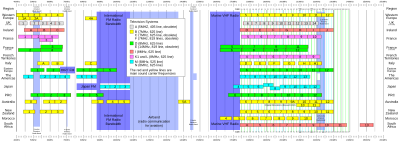625-line analog television transmission format
![]() Analog TV systems global map, with System N in orange.
Analog TV systems global map, with System N in orange.
CCIR System N is an analog broadcast television system introduced in 1951 and adopted by Argentina, Paraguay and Uruguay, paired with the PAL color system (PAL-N) since 1980.[1][2][3]
It employs the 625 line/50 field per second waveform of CCIR Systems B/G, D/K, and I, but on a 6 MHz channel with a chrominance subcarrier frequency of 3.582056 MHz[2][4][5] (similar to NTSC).
Specifications
The general System N specifications are listed below.[6][4]
 Plan showing VHF frequency ranges for ITU Systems
Plan showing VHF frequency ranges for ITU Systems
See also
Notes and references
External links
|
|---|
Television |
|---|
| Analog | | 405 lines | |
|---|
| 525 lines | |
|---|
| 625 lines |
- System B, C, D, G, H, I, K, L, N (Color systems: PAL, PAL-N, PALplus, SECAM)
- MAC
|
|---|
| 819 lines | |
|---|
| 1125 lines | |
|---|
| 1250 lines | |
|---|
| Audio | |
|---|
| Hidden signals | |
|---|
| Historical | |
|---|
|
|---|
| Digital | |
|---|
|
|
|